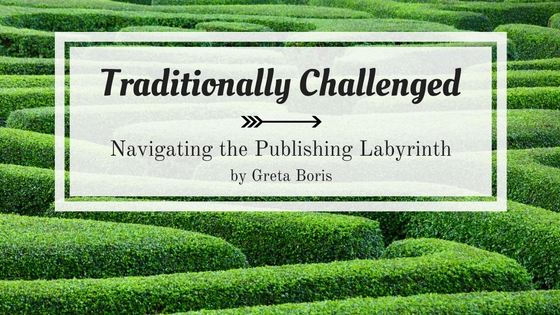by Greta Boris
I signed up for an on-line plotting course some years back and started happily typing away. I was excited about the beginning of my story and I knew, more or less, where I wanted the characters to end up. The middle was a bit vague, but I was sure the class would help solve all my pesky problems.
It didn’t.
It only exposed the issues in excruciating detail.
I discovered there was no logical way to get from the beginning to the end without going down a path leading straight into a bog. The plot just didn’t work.
My automatic reaction was to give myself a pep talk, “Stick to your goals. Push on through. Quitters never fail to fail.” However day after day, I found more reasons to avoid my lap top. I just couldn’t make myself sit down and work on the book.
I had to accept reality. The freeway was closed. The bridge had been washed away. Continuing would mean following unexpected detours into unknown territory. Lord knows where I’d wind up.

The terrible problem of the saggy middle is not unique to writers. Not by a long shot.
How often have you or a friend announced this was the year you were going to find that new job, or a meaningful relationship, or read more books, or finish the Elvis on velvet painting in your garage—then didn’t?
So how do you avoid the saggy middle?
Here are 6 hot tips. You probably have more, but you can share at the end.
Tip 1: Decide if you really want to complete the project
I know this sounds obvious, but often people make resolutions they really don’t care much about. They think they ought to care, but don’t take into account all the work involved in shaking up the status quo.
In Steven Pressfield’s book, The War of Art: Break Through the Blocks and Win Your Inner Creative Battles, he states,
Most of us have two lives. The life we live, and the unlived life within us. Between the two stands Resistance.
He contends, and I agree, resistance is a formidable force and one we have to fight if we’re going to accomplish anything of value or significance.
I don’t know about you, but I only have so much drive. If I’m watering it down by setting all kinds of goals I’m not really passionately sure I need to, want to, have to accomplish, I’m going to run out of steam.
When it came to my story, I had to decide two things: Was I absolutely sure this was a story I wanted to write? Was I absolutely married to the ending? My answer to both questions was yes. I still believed there was merit in the theme, the characters, and the outcome. On to the next step.
Tip 2: Look at a Road Map
I believe the single greatest reason people sink into the mire of the saggy middle is because they haven’t seen it coming.
Once we decide we’re really going to do it—take that trip, write that book, apply for that job—we get excited. We think our enthusiasm will act like some kind of hot air balloon and carry us over all the obstacles others have to deal with. It won’t.
At some point we’ll hit the dirt.
But, I knew all this. This is what The Wine and Chocolate Workout is about.
And, I understood from all the mistakes I made on my first three or four terrible novels, I had to plot. Stephen King may be able to let his characters meander around, but I knew from experience mine would lead me into a swamp. Which is why I signed up for the plotting course in the first place.
I had planned to do it right this time. I’d done all my homework. My story had hooks and turns in all the right places. It had tension and trials and characters that were becoming three dimensional on the page as I typed.
I still got stuck in the saggy middle! This time it was because I wasn’t true to myself.
Tip 3: Find the Right Road for You
Once you decide your trip is worth the effort and you’ve looked at the possible routes, you need to ask yourself another question: Which road is right for you?
You must pick a path that supports your values, ideals, morals, personality, and one that will lead to a successful outcome.
Picking a method that worked for someone else doesn’t necessarily make it right for you. It happens all the time in small business. Someone has a product or service they want to sell. They create a marketing plan that mirrors big business.
Every chance they get they talk about their product. They blast their good news on social media, take ads, tell all their neighbors and friends and it works. For a while. But after an initial bump, their sales drop off.
Why? It was the wrong route for them. Casting a wide net may work for big business, but the little guy will probably do better if he can look his fish in the eye.
Back to me: I plotted out a story, but when I sat back and looked at it, I realized it wasn’t my genre. I like suspense, domestic thrillers, cozy mysteries. I don’t mind if there is a touch of the supernatural or the unexpected, but this story read like a dark fantasy. That’s Megan’s territory, not mine! I had a serious edit to do.
Step 4: Once you know you’re on the right path, commit.
I read a great little ebook from Linda Formacelli, Commit. It came at a perfect time for me, and if you’ve read this far, I’m guessing it’s a perfect book for you too.
Linda suffered from panic disorder for many years. She’d tried various remedies with limited success. One day she decided she couldn’t live that way any more. She was committed to finding a cure. She threw every single remedy she could think of at her problem and beat the disorder.
In Linda’s book she lists so many methods for tackling problems you could never apply them all at once, but you’re not intended to. Rather, this book is like a brainstorming session. She encourages you to use whichever methods best fit your particular situation.
One of her suggestions was to get more education. At first, I dismissed this. Wasn’t the plotting class what got me into the saggy middle to begin with? But, I woke up the next morning knowing this was where my solution lie.
I pulled out a book I’d read a while back, Nail Your Novel: Why Writers Abandon Books and How You Can Draft, Fix and Finish With Confidence, by Roz Morris. I dove into the sections on salvaging your story and found some great solutions. I went back to the drawing board and began digging myself out of the mud pit.
Step 5 – Put it on the Calendar
When I have a magazine article due, I meet my deadlines. Without a calendar date attached to a project, it feels less important, a little unreal, and I have a tendency to procrastinate. Deadlines give goals substance.
I gave myself a week to revamp my outline, then put a one-scene-a-day goal into my daily planner.
Step 6 – Tell someone your goal
If you tell a trusted friend or adviser about your goal, you’re more likely to reach it. So, go ahead. Comment below. How are you planning to avoid, or dig out of, the dreaded saggy middle?
***

Greta Boris Director
Greta Boris is the author of the 2017 releases, A Margin of Lust and The Scent of Wrath, the first two books in her 7 Deadly Sins domestic suspense series.
She’s published articles on culture, health, and entertainment for a variety of national magazines including Victorian Homes, Zombies, 50 Scariest Movies, Exodus, and Women of the Bible. She’s also the author of the Amazon Kindle Bestseller The Wine and Chocolate Workout – Sip, Savor, and Strengthen for a Healthier Life.
You can visit her at http://gretaboris.com. She describes her work (and her life) as an O.C. housewife meets Dante’s Inferno.
*O.C. Writers is a participant in the Amazon Services LLC Associates Program, an affiliate advertising program designed to provide a means for us to earn fees by linking to Amazon.com and affiliated sites. By clicking on the book links anywhere on this site, we earn a small commission from your purchase.


Excellent! Where you reading my mind, Greta? Just what I needed. I am at that point of the questions you mention, ‘Am I absolutely sure this was a story I want to write? Am I absolutely married to the ending?’
The calendar is a great idea. Ok, by September 1, I will have three missing chapters written. By October 1, I will have written the ending chapters. By November 1, I’ll work on collaborating with an editor somehow. Plus, I’m going to tackle “Nail Your Novel” if only in bits and pieces.
Thank you for this article! I don’t want be that poor ole’ sagging horse!
oops “Were” not “Where” UGH!
Glad I could be of assistance, Billie! Let me know how it goes.